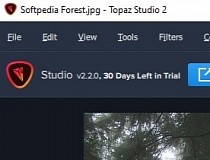

She was a gorgeous woman and I wanted to see just how well the software would hold up, starting with an image this low-res at 293×420 px. This example of singer/actress Joyce Bryant is a worst-case scenario just for testing purposes. As long as you can obtain the legal rights to your image sources, you have to make it work if you want to include the image to support your story. You may ask “why would you ever do that?” and most documentary filmmakers may attest to having to source some materials from a certain time period in their subject’s life that just aren’t obtainable any other way or the originals have been lost.
#TOPAZ STUDIO 2 FOR SCANNED SLIDES ARCHIVE#
This is the true test of any enhancement software, is that the subjects look exactly how you recall them and not an artificially-created face slapped on top.Ī real test is taking a small web archive image off a public domain stock site and making it useable. I then upscaled it only 200% and applied the Facial Recovery at about 50% to get the result on the right. Here I have first retouched the original image of my paternal grandparents (was captured with a DSLR from a family photo on a wall) and converted to B&W.

Until recent updates have included AI Face Recovery, you just got what you got and had to do further retouching to make the subject pleasing at all.īut now it does a pretty decent job of reconstructing facial details and retaining the lighting/shadows on your subjects without it looking like you copy/pasted a new head on them. However, it often distorted faces if there wasn’t a great amount of detail. It does offer a lot of control and options for refining your images and lets you preview before/after scaling in the app before committing to it. Topaz Gigapixel ($100 Desktop Application) has been around for a few years and I’ve used this application, as well as their entire suite of tools, many times with great success. Let’s take a look at just a couple of the top options available today and how they stack up… for now! Topaz Gigapixel But is it really amazing software coding or is it witchcraft? Even most archival stock images are too low resolution and lacking real facial clarity when zooming in for documentary and journalistic purposes.Įnter the brave new world of AI generated image enhancement and recovery software. These issues hold true even if you’re scanning directly from the original negatives or slide transparencies. Most issues I’ve seen while working on thousands of images are out of focus/mis-focused subjects or the subjects are too far away from the camera to get as much detail as you’d hope, or just using inferior consumer grade cameras or not enough light so there’s motion blur. It truly is magical compared to how we did things in the past.īut often these historic and archival photos that have been rumbling around in a shoebox or stuck to the pages of a family album aren’t just damaged over time from mishandling – that all still needs to be addressed, of course – but the fact that film cameras had limitations that inhibit clarity by nature. Until recent years where Adobe has added significant advancements in their tools for retouching, like Content Aware Fill and the indispensable Healing Brush, we can digitally restore and repair old photos in mere minutes. While the tools definitely changed over the years starting on Letraset ColorStudio in 1990 and Adobe catching up in Photoshop 2.5 shortly thereafter, the practice has still been pretty much the same for decades. I’ve been restoring and retouching photos commercially since the mid-80s originally using an airbrush on an enlarged photographic prints and then copy-photo’d to reduce and tighten the details for print. And we’re only just beginning to see the incredible tools that can help us dig into the past and bring people back to life! File Photo of Marylin Monroe and Jane Russell upscaled in Photoshop and AI Enhanced with Remini Web MUCH BETTER! Enter the age of AI Photo-Image enhancement software. In today’s 4K streaming world, you have to do better. What I’m seeing is not only tons of scanned photos that never get cleaned-up/retouched, but also zooms into old grainy images that barely resemble the people photographed. I’ve been watching a lot of docs and docuseries the past couple years while working on a high-profile feature doc myself, producing VFX, roto and archival image retouching and enhancements.


 0 kommentar(er)
0 kommentar(er)
